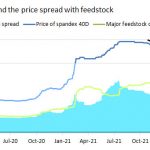Opportunities and Challenges
Radio Frequency Identification (RFID) tags take barcoding of apparel items a step further, offering merchants not only the ability to scan prices and control inventory, but also the added benefit of security. This presents some opportunities and challenges in managing the RFID process in the apparel industry. ABI Research projects usage of more than 750 million RFID tags globally by the end of 2011, with the growth in retail tagging expected to exceed the total number consumed over the past five years for all RFID markets combined.
Opportunities for Major Chains : This is, of course, a major opportunity, particularly for large apparel retailers such as Target, Macy’s, J.C. Penney, Bloomingdale’s and Wal-Mart, which are now using this approach. According to the Association for Automatic Identification and Mobility (AAIM), these retailers are currently focused on improving supply chain efficiency and making sure a product is on the shelf when customers want to buy it. The graphic below shows the apparel tracking process at Wal-Mart.
…and Boutiques : A recent (2008) case study by Motorola’s RFID solution as applied to American Apparel’s 40,000-piece Columbia University store illustrates the potential for inventory management and on-time merchandise stocking for apparel items. Because American Apparel stocks only one item if each style, color and size on the floor at one time, turnover is rapid. Once RFID tags were placed on each item of clothing and merchandise, store personnel could then use RFID readers to check inventory in real time.
Challenges in Cost and Privacy : But the challenges of implementing RFID for apparel, driven primarily from a weak global economy, are valid. Costs, and the credit necessary to meet them, could be a limiting factor, especially for smaller independent stores. Some labels need to be modified, and both suppliers and retailers must invest in new equipment. “However,” said Mark Gatehouse, director of replenishment for Wrangler jeans maker VF Corp., “we view this as an investment in where things are going. Everyone is watching closely because no one wants to be at a competitive disadvantage, and this could really lift sales.” Privacy issues are also a concern for some. “There are two things you really don’t want to tag, clothing and identity documents, and ironically that’s where we are seeing adoption,” said Katherine Albrecht, author of “Spychips” that argues against RFID technology. “The inventory guys may be in the dark about this, but there are a lot of corporate marketers who are interested in tracking people as they walk sales floors.” It’s been suggested that retailers put the smart labels on hang tags and removed at checkout. While that process maintains the inventory-control benefit of RFID, it eliminates being able to track the item all the way back to the point of manufacture in case of a recall, or making sure it isn’t counterfeit.
Future Steps : Research suggests that RFID tags can benefit the manufacturer (shipment scheduling, recall issues), the retailer (inventory control, reduced labor costs) and the consumer (convenience, cost savings, service). From all accounts, it appears that this technology will be embraced by the apparel market, particularly in larger chains or boutiques with limited display capacity. It remains to be seen if RFID codes will unilaterally replace UPC barcodes as an industry standard.






